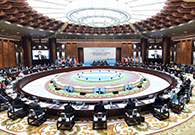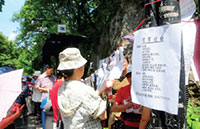Transparency seen through smog
(Xinhua) Updated: 2013-01-16 04:55BEIJING - Public criticism of the heavy air pollution behind recent hazy skies has not stopped authorities in Beijing and other smog-shrouded cities from updating their air quality readings.
Data from Beijing's environmental authorities show that readings for PM2.5, airborne particles measuring less than 2.5 microns in diameter, reached more than 300 micrograms per cubic meter of air at some monitoring stations at 5 p.m. Tuesday.
On Saturday evening, the city's environmental authorities said PM2.5 readings indicated "extreme, severe pollution," as PM2.5 readings reached as high as 900 at certain monitoring stations.
Other cities in the "pollution belt," including Tianjin and Shijiazhuang, also continued to release real-time air quality monitoring data.
Upon seeing the "horrible" data, many citizens rushed to buy protective masks or simply stayed home.
"The government is not concealing the data now. We can at least know the true conditions we are in," said Wang Tianwei, a 25-year-old from Beijing.
Wang said he was not too bothered by recent brown skies, as he can remember many other examples of extreme weather conditions.
Zhu Tong, an environmental sciences and engineering professor with Peking University, cited research showing that the air quality in Beijing has not worsened in recent years, but has remained nearly static or improved.
China previously used PM10, airborne particles measuring 10 microns or less in diameter, as its official standard for measuring air quality, but this can not assess smaller pollutants in the air, Zhu said.
"The measuring standards have been lifted, which directly contributed to higher pollution readings," he added.
People may think the air quality is worse, now that data based on stricter standards are released. But air quality may, in fact, be the same as in the past, when there was no official data to indicate such serious levels of pollution, according to Zhu.
"I think one of the things that's good to see is that the Chinese government, itself, has decided to monitor smog levels and publicize the results. So, that's a significant start in terms of taking care of the health and welfare of their own people on this issue," U.S. State Department spokeswoman Victoria Nuland said in a daily press briefing on Monday.
She said China being transparent to the Chinese public is a good step, as well as a positive response to the people's requests for more information. She also said the U.S. Embassy in China will continue to monitor the air quality and publish the results.
The Chinese government enacted new air quality standards in February last year, which included indices for ozone and PM2.5. The new standards came in response to fierce public debate that was stirred in 2011, when people took notice of the huge discrepancies between the air quality data published by the U.S. Embassy in Beijing and that of local environmental agencies.
According to media reports, the U.S. Embassy in Beijing generally published worse results than Beijing's weather forecasting station due to different measuring standards for PM2.5.
Starting January 1, 74 major Chinese cities began issuing real-time PM2.5 readings and other air quality monitoring data.
But just releasing data is not enough, said Zhu.
To speed up the eradication of heavy pollution and avoid the recurrence of smoggy days, Zhu hopes the country will mete out stricter measures to limit coal burning and reduce emissions of pollutants, which are believed to be the main reason for the lingering fog.
Jimmy Green, an American who has been working in social media in China for three years, said he was happy about China's transparency in releasing environmental data and the rising monitoring standards.
"Although I, myself, still suffer from the terrible fog, I can feel the government's resolution to change," he added.
- China concerned over downgrade of panda's conservation status
- First lady highlights China's fight against AIDS
- Beijing takes firm stance opposing HK agitators
- Nobel laureate Tu Youyou's team makes new progress on artemisinin research
- Giant panda no longer endangered - WWF
- Action, not words needed to lift economy
- CCDI shows progress in hunt for corrupt officials
- Old tale inspires modern marriage market
- Xi urges efforts of BRICS to improve global governance
- Premier Li offers condolences over death of Uzbek President Karimov










